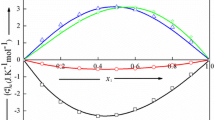Abstract
The excess properties of the mixture bis(2-dichloroethyl)ether (chlorex) + 2,2,4-trimethylpentane (isooctane), i.e. excess volumev E, excess enthalpyh E, excessGibbs energyg E and excess heat capacityc Ep are reported. The excess volume is small, negative on the chlorex side and positive on the isooctane side. The excess enthalpy at 293.15 K is 1 913 J mol−1 for equimolar composition, the excessGibbs energy amounts to 1 367 J mol−1 under the same conditions. The system undergoes phase separation below 290.47 K. Due to the nearness of the critical point,c Ep exhibits a strong maximum at the critical composition (x isooctane=0.508), though the basic part ofc Ep is negative. Discussion focusses on the effects of polarity of chlorex as mixing partner, on near-critical properties, and on mixing rules of avan der Waals-type equation of state.
Zusammenfassung
Die Exzeßeigenschaften der Mischung Bis(2-dichlorethyl)ether (Chlorex) + 2,2,4-Trimethylpentan (Isooktan), d.s. Exzeßvolumenv E, Exzeßenthalpieh E, Exzeß-Gibbs-Energieg E und Exzeß-Wärmekapazitätc Ep werden berichtet. Das Exzeßvolumen ist klein, negativ auf der Chlorex-Seite und positiv auf der Isooktan-Seite. Die Exzeßenthalpie beträgt für 293.15 K und äquimolare Zusammensetzung 1 913 J mol−1, die Exzeß-Gibbs-Energie 1 367 J mol−1 unter den gleichen Bedingungen. Das Mischsystem zeigt eine Phasentrennung unterhalb von 290.47 K. Wegen der Nähe des kritischen Punktes hat die Exzeß-Wärmekapazitätc Ep ein starkes Maximum bei der kritischen Zusammensetzung (x isooctane=0.508), obwohl der Basis-Anteil vonc Ep negativ ist. Die Diskussion behandelt die Effekte der Polarität von Chlorex als Mischungspartner, die Eigenschaften infolge der Nähe des kritischen Punktes und Mischungsregeln einer Zustandsgleichung vomVan-der-Waals-Typ.
Similar content being viewed by others
References
Kalali H, Kohler F, Svejda P (1985) Fluid Phase Equil 20: 75
Tschamler H, Wettig F, Richter E (1949) Monatsh Chem 80: 572
Siddiqi MA, Götze G, Kohler F (1980) Ber Bunsenges Phys Chem 84: 529
Kalali SEH (1984) Doctoral Thesis, Ruhr-Universität Bochum
Hahn G,Svejda P,Kehiaian HV, Fluid Phase Equil (accepted for publication)
Roux AH, Grolier J-PE, Inglese A, Wilhelm E (1984) Ber Bunsenges Phys Chem 88: 986
Wilhelm E, Grolier J-PE, Karbalai Ghassemi MH (1977) Ber Bunsenges Phys Chem 81: 925
Kohler F (1957) Monatsh Chem 88: 388
Kohler F, Findenegg GH, Bobik M (1974) J Phys Chem 78: 1709
Kohler F (1957) Monatsh Chem 88: 857
Guggenheim EA (1952) Mixtures. Oxford University Press
See eg, the corresponding coefficients of benzene + cyclohexane, and cyclohexane + carbon tetrachloride, as given byKohler F, Gaube J (1980) Polish J Chem 54: 1987
Widom B, Khosla MP (1980) JCS Faraday (I) 76: 2043
Bloemen E, Thoen J, van Dael W (1980) J Chem Phys 73: 4628
Sanchez G, Meichle M, Garland CW (1983) Phys Rev A 28: 1647
Binder K (1984) in:Lovesey SW, Scherm R (eds) Condensed matter research using neutrons. Plenum, New York, p 1–38
Kohler F, Svejda P (1984) Ber Bunsenges Phys Chem 88: 101
Kohler F, Kohlen R, Svejda P (1986) Fluid phase equil 27: 189
Svejda P, Kohler F (1983) Ber Bunsenges Phys Chem 87: 672
Reschke F (private communication)
Hahn G (private communication)
Riddick JA, Bunger WB (1970) Techniques of chemistry II (Organic Solvents) 3rd edn. Wiley, New York
Tschamler H (1950) Österr Chem Ztg 51: 145
Author information
Authors and Affiliations
Additional information
Dedicated to Prof. Dr.K. Komarek on the occasion of his 60th birthday.
Rights and permissions
About this article
Cite this article
Kalali, H., Kohler, F. & Svejda, P. Excess properties of the mixture bis(2-dichloroethyl)ether (chlorex) + 2,2,4-trimethylpentane (isooctane). Monatsh Chem 118, 1–18 (1987). https://doi.org/10.1007/BF00810035
Received:
Accepted:
Issue Date:
DOI: https://doi.org/10.1007/BF00810035




